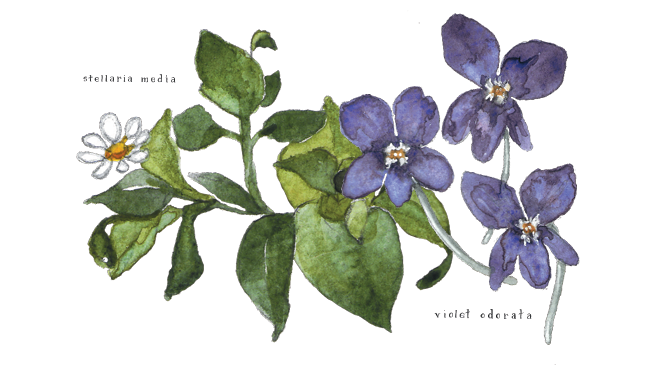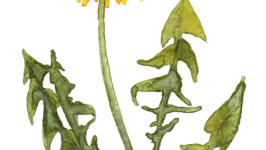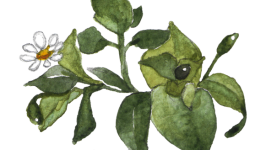Spring Tonics
It has been a brisk morning, steam rising from my morning coffee, as I await the light dusting of frost to melt by the mid-day sun. I have gathered the equipment of the foraging herbalist: my hands and my harvesting basket. I will not have to wander far today to find the tonic herbal allies I am searching for. As only “weeds” do, they grow in perfect abundance on this small acre opening on the edge of the woods where I live. I am fortunate, you see, to live on land free from polluting influences such as road runoff, pesticides or pedestrians and their pets. It is a safe place to grow herbs, and to harvest them in the wild.
In the woods surrounding my home, the ramps are starting to rise and any day now its shady hollows will be carpeted with the leopard-spotted leaves of white and yellow trout lilies, nodding heads of trillium flowers and the blushing of hepaticas. As when emerging from the darkest places, we feel the most alive. This is Ohio’s spring season.
I walk up the hill behind my house and follow the tree line to a patch of cleavers (Galium aparine) that I have had my eyes on for a few weeks. It has grown tall and juicy, clinging to the various clumps of fescue interspersed with sassafras seedlings and skeletons of last year’s fleabane. This is a wonderful herb for supporting the lymphatic system, a body system that is not only involved in the absorption and distribution of dietary fats, but that which houses our immune response and which filters our blood plasma. Herbalists of old wrote in metaphor of cleavers being the perfect herb to clarify the “waters of the body.” This patch of cleavers will be tinctured fresh in alcohol for clinical use.
I will also be adding some cleavers, which are packed full of minerals, to my infamous “Spring Tonic Vinegar” as well as juicing some and freezing them in ice cube trays to add to morning smoothies. The key here is fresh (no drying for cleavers), for I was taught and have always believed the true benefits of this herb come from its juices. Harvesting is a breeze. I giggle as I pull from my clothing stalks of the plant that would rather cleave to my sleeves than go into the basket.
My next stop will be one of my production gardens, a dedicated space for medicinal herbs that I rotate in and out after harvesting in the fall. On my way, however, I will be taking a knee for the bright-eyed common blue violet flowers (Viola sororia) and their heart-shaped leaves that have only just started to make a show amongst the brave dandelion flowers. The violet flowers are slightly sweet to the taste and will make such a lovely addition to our dinner salad this evening (they also make a delightful garnish on cakes and pastries).
The real work of the common blue violet harvest, however, will be that of the leaves, as I crawl upon the earth, combing the lawn for the perfect specimens. Violet leaf is one of my most cherished demulcents, a term used by herbalists to indicate an herb’s cooling and moistening nature. Full of complex sugar molecules known to form a gooey, snotty substance called mucilage, I turn to violet leaf to cool and soothe mucous membranes of respiratory systems, which have become hot and irritable with seasonal allergies. Violet leaf helps to “put out the fire,” so to speak, and like cleavers is best used fresh.
When I arrive at my final harvesting destination, I am greeted by a verdant entanglement of chickweed (Stellaria media) blanketed upon the soil of the garden. Most handfuls go to the basket, but on occasion I have been known to shove an entire fistful into my mouth, savoring the cucumber-like watery crispness of this incredible edible and medicinal plant. It has a long and trustworthy reputation as an alterative, or “blood-cleanser.” With its cooling, moistening properties, it is often employed by herbalists for manifestations of “excess heat in the blood” as may be interpreted from the presence of inflammation of the joints and the skin.
I prefer to eat as much chickweed in the spring as I can, adding it to my Spring Tonic Vinegar, hummus, pesto and, of course, mounding it atop of spring green salads.
I arrive on my back porch, kicking the mud off my boots before taking them off to enter the house. I separate the herbs, violet leaf from flower, from long strands of chickweed and cleavers. It has been a spectacular, rejuvenating day. I have been nibbling on this collected bounty every step of the way. I can feel my body and my mind imbibing the lightness, freshness and vitality of these spring herbal allies. I am feeling vital, too, and looking forward to capturing the progress of the spring season with my bare hands and harvesting basket.
-Original Illustrations by Sharon Teuscher, composite image by publisher.







